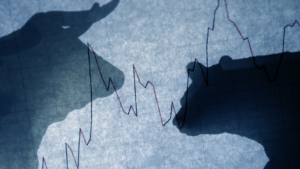Everything To Know About a Crypto Bear Market in 2023

Even the most accomplished athletes need rest to preserve their health. Financial markets, too, sometimes need to reset after a record-breaking performance, which is probably why bear markets exist. Below is everything one should know about bear markets.
What Is a “Bear Market”?
A bear market develops when a market price decreases considerably over a sustained period. It is a period in which the value of shares falls by 20 percent or more from recent highs owing to widespread pessimism and poor market sentiment. Bear markets often coincide with big declines in a larger market or index. Since Bitcoin and Ethereum are the leaders of the crypto space, and after them, the whole market looks to those cryptocurrencies to set the tone for the markets.
Cryptocurrencies or commodities may also be classified as being in a bear market if they see a 20% decline over a lengthy period—typically two months or more. Bear markets may also occur in connection with more significant economic downturns, such as recessions, and can be contrasted with bull markets which occur when the markets are heading higher.
Understanding Bear Markets
Bear markets may last for years or just a few weeks.
Secular bear markets often last between 10 and twenty years and are characterized by sustained returns below the market average. Yet, the market changes in crypto are much faster and could be as fast as every hour.
Stock prices often reflect a company’s expected future cash flows and profitability. When growth prospects weaken and expectations are dashed, stock prices may decline. Herd behavior, fear, and a hasty attempt to hedge against poor returns may lead to prolonged periods of asset price deflation.
According to one definition of a bear market, markets enter bear territory when crypto declines by 20% from their high. However, 20% is a subjective figure, just as a 10% decline is a fictitious reference point for a correction.
The Causes of a Bear Market
A bear market often strikes before or after the economy’s recession. Investors closely monitor critical indicators such as hiring, wage growth, inflation, and interest rates to assess the economy’s health. In the COVID-19 pandemic, several symptoms were slightly different, and numerous economic restrictions due to closures, unemployment claims, and social distancing measures indicated the economy was in danger.
When investors see an economy declining, they predict a sharp decline in firm profits. Consequently, they sell their equities, resulting in decreased prices and lower markets. A bear market might foretell more unemployment and more challenging economic circumstances in the future.
- First, there was the unraveling of Terra, an entire crypto ecosystem that came crashing down from the lofty heights of $60bn to almost nothing. Terra shot to fame through it’s unique stablecoin UST which, unlike most competitors, did not require an obscene amount of collateral to keep its price at $1. Rather, UST was an ‘algorithmic stablecoin’ designed to keep its peg through complex financial engineering. Not only were UST holders convinced that their asset was a relatively safe stablecoin worth $1, but they also took advantage of the 20% return available to them for depositing their UST into a platform called Anchor. When the poorly-designed stablecoin, the unsustainably high yields, and unfavorable market conditions were met, chaos ensued.
- Then came the knock-on effects. Companies like Celsius which had a decent amount of exposure to the Terra ecosystem suddenly found themselves on the brink of insolvency and paused withdrawals. It wouldn’t be long before others, like 3 Arrows Capital, Voyager, and even the crudely-named Coinflex would follow suit and pause withdrawals. Max pain.
- The NFT market had a year-long manic wave that saw its fair share of scams, rug pulls, abandoned projects, and false promises.
- All this was happening as Bitcoin adoption was stalling worldwide. Institutional adoption of Bitcoin, as evidenced by public companies and mutual funds adding Bitcoin to their balance sheet is slowing down. If this bull market was kicked off by companies like Microstrategy and Tesla buying crypto, the lack of institutional action is dragging any hope of another leg up. Despite rumors of Apple and others stocking up on BTC, no public companies have brought any Bitcoin since Michael Saylor and Elon Musk threw their hats in with the crypto crowd.
- Finally, the biggest shoe to drop was the collapse of FTX. The exchange and its founder, Sam Bankman Fried, were once upon a time the darling of crypto. However, once a rival in the form of CZ, CEO of Binance, started raising doubts about FTX’s solvency, it wasn’t long before customers got jittery and, in a self-fulfilling prophecy, the company declared that it was pausing withdrawals before eventually filing for bankruptcy. In the aftermath of the crash, it was discovered that FTX and its officers had been using customer funds to further their own interests, leaving billions of dollars worth of debt unaccounted for. Bankman-Fried was charged by the Department of Justice and, as of this writing, is on bail awaiting trial.
Bear vs. Bull Market
Both “bull” and “bear” are sometimes used to refer to individuals or organizations that function differently. Bulls buy stock on the assumption that the market will soon increase, while bears purchase stock on the belief that the market will experience a decline. A bull market is when prices inside a given area need to increase significantly or are forecast to rise. A bull market exists when prices climb by more than 20% after two 20% losses. When markets are bullish, it is seen as a sign that the economy is growing and doing well.
A bull market is when prices inside a given area need to increase significantly or are forecast to rise. A bull market exists when prices climb by more than 20% after two 20% losses. When markets are bullish, it is seen as a sign that the economy is growing and doing well.
Additionally, a bull market has a strong demand for shares, and price increases often occur over an extended period. However, given the bitcoin market’s volatility throughout history, some use terms like “optimistic” and “bearish” more loosely. The price of a coin might swing by 20% within hours or days, and this kind of volatility is commonly characterized as bullish or bearish.
Bear Market: Bull markets are opposed to bear markets. This happens over time when market trends indicate that prices will decrease by 20%, and a decline often follows this activity in demand for equities and investor interest.
Bear Markets vs. Corrections
Contrary to popular belief, a bear market is not synonymous with a correction, which is a trend that lasts less than two months. While revisions provide a fantastic entry point for value investors, negative markets seldom offer such chances. This barrier occurs because it is tough to determine the bottom of a bear market.
Short Selling in Bear Markets
In a falling market, an investor may gain by selling borrowed shares. This strategy entails selling borrowed shares and repurchasing them at a discount. In traditional equities, a seller must first borrow the shares from a broker before being able to place an order. Profits and losses are calculated by the repurchase price when the seller closes his short order.
Crypto trading strategies:
A successful trading strategy may lessen the financial risk, especially in times of uncertainty, so that investors do not make hasty judgments that may cost them a lot of money.
The following are a some of the most common strategies used by bitcoin traders:
Day trading strategy
It comprises buying and selling positions on the same day. When traders place trades, their purpose is to profit from intraday price changes in their favored cryptocurrency. Investors often use technical indicators to discover the optimal exit and entry points for a specific cryptocurrency.
Swing trading strategy
Swing trading is a kind of trading in which investors maintain positions briefly. It applies to nearly every type of asset ( forex, crypto, etc.). There are two types of investors: day traders and long-term investors. Day traders employ leverage and short-term trading tactics to benefit from minor price fluctuations in liquid or actively traded currencies or equities. On the other hand, long-term investors are ready to tolerate a certain degree of risk in exchange for possibly more significant gains and more affordable to be patient for a longer time.
INX urges investors to be updated on what’s going on in the market today in order to make the right choices according to one’s own financial situation and needs. At INX, clients can trade cryptocurrencies with confidence, even in times of uncertainty. We are a regulated company providing a sophisticated, trustworthy, and user-friendly trading platform.
Start your financial journey today by opening an account with INX.
FAQ:
What are the three characteristics of a bear market?
- The stock market is in a downward spiral—a 20% or more decrease (over two months) in price from recent highs.
- Investors often experience fear and pessimism.
- Frequently, the country’s economy (or, at the very least, its economic prognosis) is unfavorable.
What is a bear trend?
A bear market is described as a downward trend in crypto prices in a particular sector or a general decline in broad market indexes in financial markets. The bearish trend is defined by widespread investor pessimism about the likelihood of dropping market prices.
How does one profit from a bear market?
In a down market, short positions, put options, and short ETFs are all methods to profit. Long positions, call options, and exchange-traded funds (ETFs) are all methods to benefit from a bull market.
The INX Digital Company INC January 16, 2021
The INX Digital Company inc. is an expert in the field of finance, crypto and digital securities.






